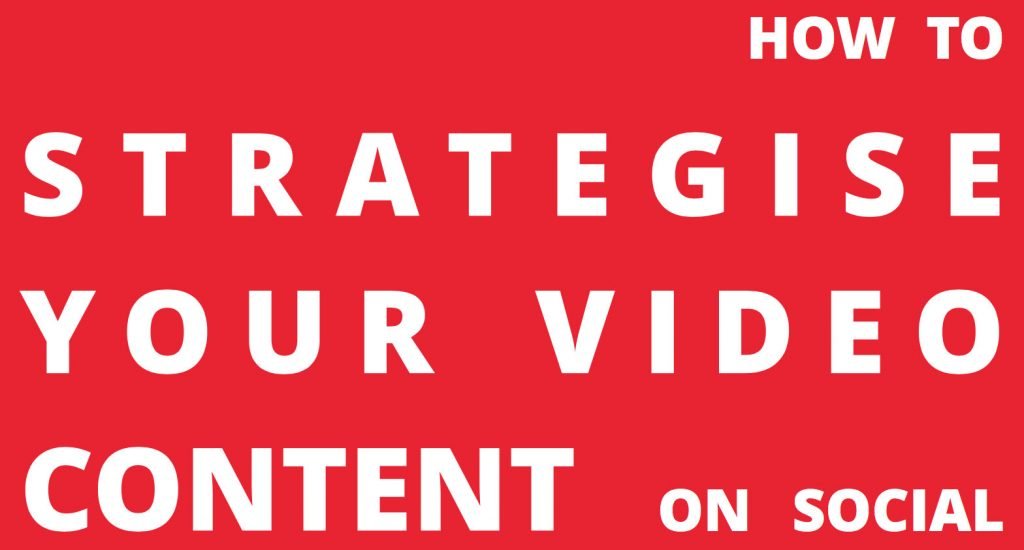If you are looking to create great video content then you wall almost certainly be thinking about how to strategize your video content on social media channels. Click this content strategy free download link for our 52 page guide.

What is content strategy?
Distilled.net have defined content strategy as the following:
‘A content strategy is the high-level vision that guides future content development to deliver against a specific business objective.’
Your ‘high-level vision’ should overarch everything and all your content should relate to this vision. You will always have a ‘specific business objective’ and all your content should be helping you achieve this objective. If it isn’t, your content isn’t doing its job.
If you don’t have a clear strategy to keep referring to, you’ll have a lack of direction, and a lack of direction can lead to generic content. Content like this doesn’t make the grade. It doesn’t get shared, it doesn’t get watched, it doesn’t engage. And if it does none of those things, it won’t be helping you achieve your business objective. Equally, if your video content agency can’t see your vision, how will anyone else?
If you have time then read through our 52 page guide to content strategy. Just click the Content Strategy Free Download button in the section above.

Research is key when developing a content strategy. Remember the 3 C’s:
- Company
- Customer
- Competitor
Company: unearth the brand values and strengths of your company. What does your company stand for? Why are you in the business?
Customer: understand the needs and wants of your customers. How do they decide to buy? What matters to them?
Competitor: look at the brand values of your competitors. What are their selling points? How do they communicate it to their customers? Is it working?
Content atomisation
Content atomisation is sharing your idea/concept/campaign across multiple marketing channels. This allows you to make the most of the different platforms and their users. Each channel has a different audience and they want to see different digital content.
Atomisation works when you stick to your theme and your content is relevant. If the content isn’t relevant to them, your audience isn’t going to be interested. No audience is the same and atomisation allows you to reach your audience on different channels. Atomisation means you can capture everyone, be it using different social media channels, different media and different styles – the same style isn’t going to work on all platforms in all channels.

Social platforms
Social media has to be part of your content strategy, there’s no way about it. Social media platforms need a whole post to themselves, there is THAT much I could say on the matter. With so many of us spending so much time scrolling through various social media channels, it is the place you need to make the impact most. Think about how your content will be different on different platforms. For instance, you need to remember that the time limits for video content on Twitter, Instagram and Facebook are completely different. Twitter is 30 seconds, Instagram is 1 minute and Facebook 45 minutes. So, on platforms like Twitter and Instagram, you need to get your point across pretty quickly or that brand story video will go to waste.
Native uploads
A ‘native upload’ means you are directly sharing content to a certain network. You aren’t providing a link to an external site and you aren’t asking your audience to leave the page. If I click on an article and it starts redirecting me to another page, I close it down. I don’t want to be redirected to someone’s page if they can’t be bothered to create content for more than one platform. Native uploads stop this from happening, directly sharing on a network means people will stay on that network. If they didn’t want to be reading an article on Facebook they wouldn’t be on Facebook. Use native content to reach more people in a more consequential way.
Titles, descriptions and tags
You can upgrade search results with the use of titles, headlines, descriptions, tags and hashtags. I could also witter on about this for hours, so I’ll keep it as brief as I can.
The title should contain all keywords you are looking to ‘rank’ on. The most important one should be at the beginning, followed by the second most and finished with the name of your brand. Making sure you use the right keywords can have a huge effect on traffic to your site.
A meta description is the paragraph of text placed in the HTML of a page describing its content. It is also known as a snippet. Just like a snippet of information, you want to keep it short and sweet. There is a character limit, so there is only so much you can fit in – so keep it relevant. The better this is the more likely someone will reward you with a click.
When thinking about tagging you need to target your key fields. The most well known example of tagging is the hashtag. This enables content to be sorted by this particular tag (e.g. “#nofilter”), and allows users to locate content based on that tag alone. Think along these lines when you are tagging digital content, keep it easy, keep it simple and keep memorable.
Calls to action
All your content should have a call to action. Otherwise how are you going to encourage your audience to do what you want them to do? You aren’t, is the short answer. If you watch a video on a new pair of trainers, and you get to the end of it and there’s nothing that tells you how to buy them, you aren’t going to buy them. Equally, if the call to action doesn’t stand out, you might miss it and move on. Calls to action need to be obvious and easy to recognise.
When asking a user to complete a call of action they are taking a leap of faith. They are trusting you with their information, be it email address or more personal details. When asking someone to do this you need to address any concerns or questions they may have. For example, if you are asking someone to subscribe to a newsletter, point out how easy it is to unsubscribe at a later date. If you are asking someone to buy something, let them know how simple it is to return it if they don’t like it.
Also, consider if you are asking the user to respond to your call to action at the right time. If the first thing I see when I enter a clothing website is a pop up to register my email for a 10% discount code, I close it. It’s too early. I haven’t been able to look at the products yet to decide whether I am going to buy anything, let alone decide I want a discount.
Posting times
Think about the times that your audience will be online. If you are trying to attract a US audience, posting at 7pm UK time may not be the best idea. Top social media marketers know which time of day gets the most shares and the most clicks. They know when people are looking at certain channels and what digital content they are looking for.
There’s an excellent infographic here which shows you in much simpler and descriptive terms than any wordy paragraph could.
Paid promotions
Using paid promotions you can target users by areas of interest, gender, geography or type of device. This means you can easily get your content in front of your audience. Good examples of these are promoted Tweets and highly targets Facebook ads, which we’ve all seen.
When you are looking at paid opportunities such as these, you need to look at it a bit differently. You want people to engage by sharing and commenting on the content. If you pose a question people will want to know the answer. If you show a problem, people will want to know the solution. You need to draw people in with these techniques if you are going to make the most out of paid promotions. Get even more insights from our content strategy free download.
As I said, I could write for hours on all of these topics and in great detail. But you wouldn’t last until the end of the blog post and I don’t want to be responsible for you falling asleep in front of the screen. This post should get you thinking about all the things you need to consider when it comes to content strategy and for a more in-depth look just select our content strategy free download link at the top of this page.
